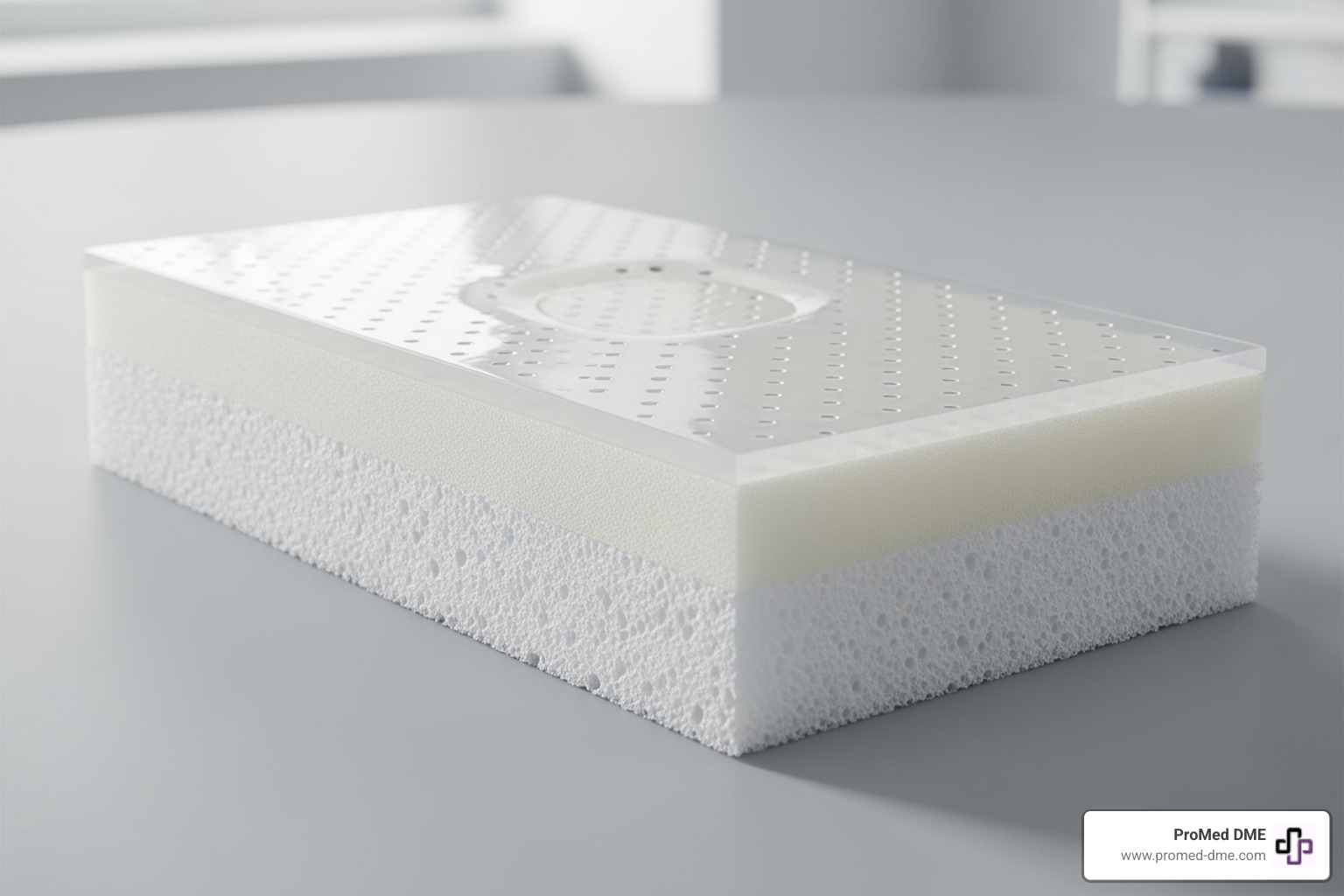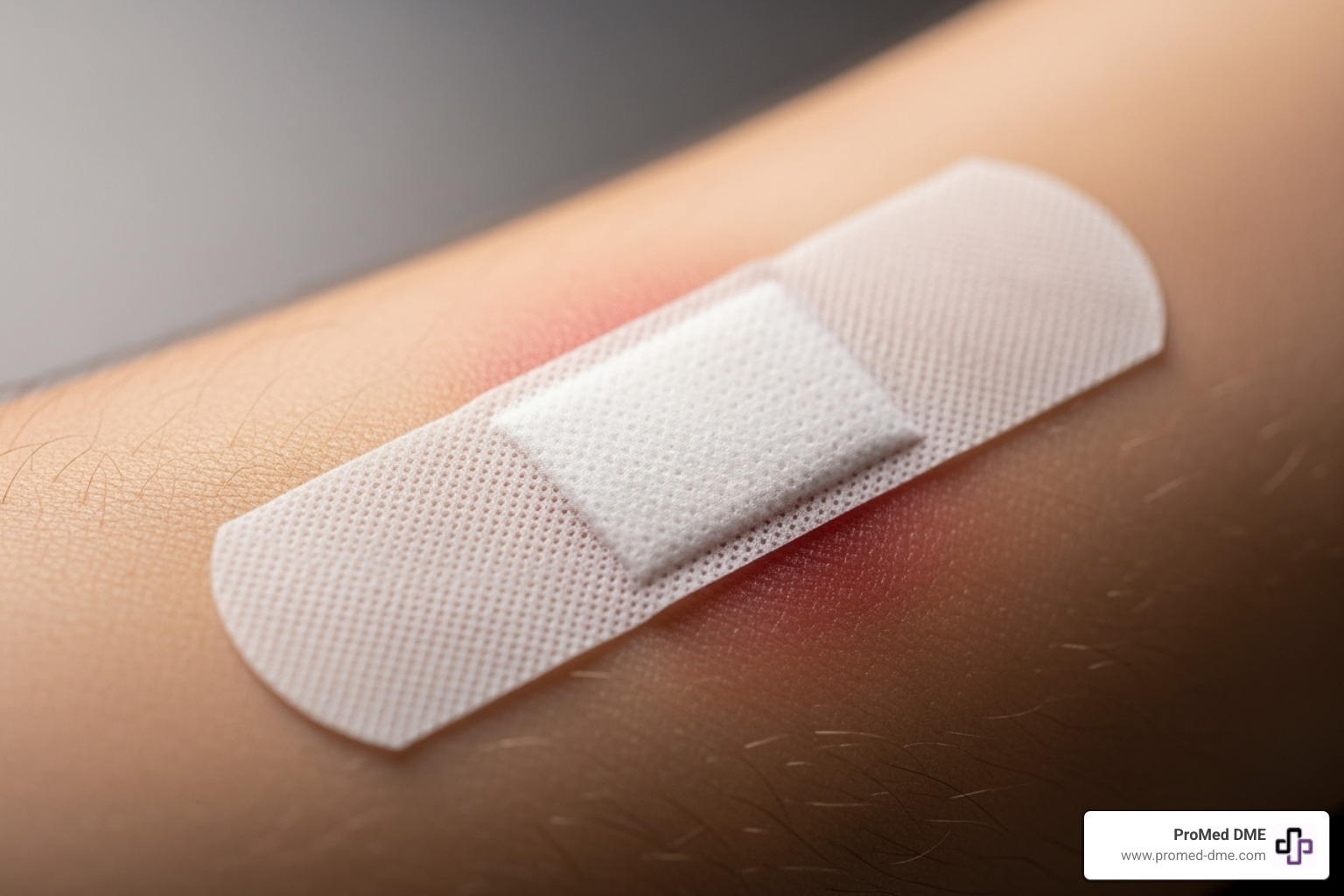The How-To Guide for Dressing Injuries: Best Practices and Advice

Introduction
When it comes to dressing injuries, understanding the basics can make a big difference. Whether it's a minor cut, an abrasion, or a more serious wound that requires medical attention, the principles of wound care are the same.
Quick Answer for Dressing Injuries:1. Assess the bleeding: Check how much blood is coming out.2. Clean the wound: Use water or a saline solution.3. Select the right dressing: Choose based on the wound type and stage.4. Cover the wound: Protect it from contamination.
Wound healing is a complex process that involves several stages, usually starting with inflammation and ending with the maturation of the extracellular matrix. Each phase requires different care techniques and dressing types to ensure proper healing and minimize infection risks.
Wound assessment is the first step in this process, where you evaluate factors like the depth of the wound, amount of exudate, and presence of any infection. This assessment will help you make informed decisions about the most suitable wound dressing to use.
Dressing selection is crucial. The right dressing not only protects the wound but also provides a moist environment that is known to promote faster healing, reduces pain, and enhances patient comfort.
ProMed DME is here to help you navigate this essential part of medical care with ease and confidence.

Understanding Wound Types
Before diving into the details of dressing injuries, it's important to understand the different types of wounds. Each type has unique characteristics and requires specific care.
Superficial Wounds
Superficial wounds are minor injuries that affect only the outermost layer of skin, such as cuts, scrapes, and abrasions. These wounds usually heal quickly and can often be treated at home.
Key Points:- Clean the wound with mild soap and water.- Apply a simple dressing like gauze or a bandage.- Keep the wound moist with a wound-healing gel or topical cream to speed up healing.
Deep Wounds
Deep wounds penetrate through multiple layers of skin and may reach underlying tissues like muscles or bones. These wounds are more serious and often require medical attention.
Examples:- Puncture wounds- Lacerations- Surgical incisions
Key Points:- Clean the wound thoroughly to remove debris.- Use advanced dressings like foam or alginate that can be bought over the counter.- If the wound is secreting or at risk of infection, consult a specialist.
Chronic Wounds
Chronic wounds are those that do not heal within the expected time frame, often due to underlying medical conditions like diabetes or poor circulation. These wounds require specialized care.
Examples:- Diabetic foot ulcers- Pressure ulcers- Venous leg ulcers
Key Points:- Chronic wounds often benefit from collagen dressings.- Keep the wound clean and moist to promote healing.- Consult a wound care specialist for tailored treatment plans.
Infected Wounds
Infected wounds show signs of bacterial invasion and need immediate medical attention. Indicators of infection include redness, swelling, pus, and a foul odor.
Examples:- Infected cuts- Infected surgical wounds
Key Points:- Clean the wound with saline solution.- Use dressings with antimicrobial properties, like silver dressings.- Seek medical attention if the infection persists or worsens.
Understanding these wound types helps in choosing the right dressing and care approach. ProMed DME offers a wide range of wound care supplies to meet your needs.
Next, we will explore how to select the right dressing for each type of wound.
Selecting the Right Dressing
Choosing the right dressing is crucial for effective wound healing. Let's explore the different types of dressings and when to use them.
Gauze
Gauze dressings are versatile and commonly used. They are made from woven cotton and come in various forms like sponges and rolls.
When to use gauze:- Infected wounds: Gauze can be changed frequently to manage infection.- Wounds needing packing: Gauze can fill deep wounds.- High exudate wounds: Gauze absorbs excess fluid.
Gauze is a good option for wounds that require regular monitoring and dressing changes.
Foam
Foam dressings are made from polyurethane foam and are excellent for moderate to heavily exuding wounds. They provide cushioning and absorb a lot of wound exudate.
When to use foam:- Pressure ulcers: Foam dressings prevent further pressure damage.- Diabetic foot ulcers: They manage exudate and protect the wound.- Surgical wounds: Foam dressings offer cushioning and absorb excess fluid.
Foam dressings are ideal for wounds that need both protection and absorption.
Transparent Film
Transparent film dressings are thin, flexible, and waterproof. They allow you to see the wound without removing the dressing.
When to use transparent film:- IV sites: Keeps the area sterile and visible.- Superficial wounds: Protects minor cuts and abrasions.- Post-surgical incisions: Protects the wound while allowing observation.
These dressings are great for wounds that need visibility and protection from moisture and bacteria.
Hydrocolloid
Hydrocolloid dressings are absorbent pads that form a gel when they come into contact with wound exudate. They maintain a moist environment, which promotes healing.
When to use hydrocolloid:- Pressure ulcers: Keeps the wound moist and promotes faster healing.- Minor burns: Protects and hydrates the burn area.- Venous ulcers: Manages exudate and protects the wound.
Hydrocolloid dressings are useful for wounds that benefit from a moist healing environment.
Hydrogel
Hydrogel dressings are made of water or glycerin-based gels. They are used to hydrate dry wounds and promote autolytic debridement.
When to use hydrogel:- Dry or dehydrated wounds: Adds moisture to aid healing.- Radiation dermatitis: Soothes and hydrates the skin.- Necrotic wounds: Helps in gentle debridement.
Hydrogel dressings are ideal for wounds that need extra moisture and gentle cleaning.
Choosing the right dressing involves understanding the wound type, the amount of exudate, and the specific needs of the wound. ProMed DME offers a wide range of dressings to suit every wound care requirement.
Next, we will provide a step-by-step guide to dressing a wound effectively.
Step-by-Step Guide to Dressing a Wound
Dressing injuries properly is crucial for promoting healing and preventing infection. Follow these steps to ensure effective wound care.
Clean the Wound
Before applying any dressing, it’s essential to clean the wound thoroughly. This helps remove dirt and debris and reduces the risk of infection.
- Wash your hands thoroughly with soap and water. If available, wear sterile gloves.
- Rinse the wound with clean water. You can use a saline solution or mild soap to help cleanse the area. Avoid using hydrogen peroxide, as it can harm the tissue.
- Remove debris using sterilized tweezers if necessary. Be gentle to avoid causing more damage.
- Pat the wound dry with a clean, sterile cloth or gauze pad. Ensure the area is completely dry before proceeding.
Apply Antibiotic Ointment
Applying an antibiotic ointment can help prevent infection and keep the wound moist, which aids in healing.
- Squeeze a small amount of antibiotic ointment onto a clean finger or applicator.
- Gently spread the ointment over the wound. Ensure it covers the entire wound area but avoid using too much.
Choose the Dressing
Selecting the right dressing depends on the type and condition of the wound. Here are some common options:
- Gauze: Ideal for minor cuts and abrasions. It absorbs exudate and protects the wound.
- Foam: Suitable for wounds with moderate to heavy exudate. Provides cushioning and maintains a moist environment.
- Transparent Film: Good for superficial wounds. Allows you to monitor the wound without removing the dressing.
- Hydrocolloid: Best for wounds with low to moderate exudate. Forms a gel-like covering to keep the wound moist.
- Hydrogel: Perfect for dry or necrotic wounds. Adds moisture to aid in healing and debridement.
Secure the Dressing
Properly securing the dressing ensures it stays in place and protects the wound from contaminants.
- Cut the dressing to a size that covers the wound and extends about an inch beyond the edges.
- Peel off the backing if using an adhesive dressing. Avoid touching the adhesive side to maintain sterility.
- Place the dressing over the wound. Smooth it out from the center to the edges to remove air bubbles.
- Secure with tape or a bandage if needed. Ensure it’s snug but not too tight to avoid restricting blood flow.
By following these steps, you can effectively manage wound care and promote faster healing. Next, we will discuss special considerations for different types of wounds.
Special Considerations in Wound Care
When it comes to dressing injuries, some wounds need extra attention. Let's dive into specific types of wounds and how to manage them effectively.
Pressure Ulcers
Pressure ulcers, also known as bedsores, occur due to prolonged pressure on the skin. They're common in people who are bedridden or have limited mobility.
Key Points:- Stage I: Red, unbroken skin. Use a transparent film dressing to monitor the wound.- Stage II: Shallow, open sores. Hydrocolloid dressings are ideal here.- Stage III & IV: Deep wounds reaching muscles or bones. Foam dressings are effective for these stages due to their cushioning and absorption properties.
Example:A study by Payne et al. (2009) showed that modern foam dressings were more cost-effective than traditional saline gauze for treating stage II pressure ulcers.
Diabetic Foot Ulcers
Diabetic foot ulcers are a serious complication of diabetes, often leading to infections and even amputations if not managed properly.
Key Points:- Clean the wound regularly to prevent infections.- Hydrogel dressings can help keep the wound moist and promote healing.- Monitor for signs of infection like redness, swelling, or pus. Seek medical attention immediately if these occur.
Case Study:Everett and Mathioudakis (2018) emphasized the importance of regular monitoring and using advanced dressings like hydrogels to manage diabetic foot ulcers effectively.
Burn Wounds
Burns can vary from minor to severe, and each requires a different approach.
Key Points:- Superficial Burns: Use transparent film dressings to protect the wound while allowing it to breathe.- Partial Thickness Burns: Hydrocolloid dressings are suitable as they maintain a moist environment.- Full Thickness Burns: These require more complex care, often involving foam or alginate dressings to handle heavy exudate.
Statistic:According to a review in the International Wound Journal (2004), hydrocolloid dressings have been effective in treating minor burns by providing a moist healing environment and reducing pain.
Surgical Incisions
Surgical wounds need careful handling to avoid complications like infections.
Key Points:- Initial Care: Use sterile, adhesive waterproof dressings to protect the incision.- Monitoring: Transparent film dressings allow for easy observation without removing the dressing.- Healing Stage: Switch to lighter dressings like hydrocolloids or foams as the incision heals.
Quote:"Proper wound care is essential to prevent adverse consequences," says Errol Britto in a comprehensive guide on wound dressings.
By understanding these special considerations, you can ensure that each type of wound receives the best possible care. Next, we'll answer some frequently asked questions about dressing injuries.
Frequently Asked Questions about Dressing Injuries
When should I change the wound dressing?
The frequency of changing a wound dressing depends on several factors, including the type of wound, the amount of fluid or exudate, and the type of dressing used.
- Highly exudative wounds: These wounds produce a lot of fluid and may require daily dressing changes.
- Dry or healing wounds: These wounds might need less frequent changes, typically every two to three days.
- Wet or dirty dressings: Always change a bandage if it becomes wet or dirty, or if it starts peeling off.
Using the right type of bandage, like those offered by ProMed DME, can sometimes extend the time between changes due to their superior absorbent and protective properties.
Can I shower with a wound dressing?
Yes, you can shower with a wound dressing, but it depends on the type of dressing you are using. Here’s how to do it safely:
- Use a waterproof cover: Specialized products can cover the dressing to keep it dry while showering.
- Avoid direct spray: Keep the wound out of direct streams of water to prevent the dressing from getting soaked.
- Pat dry: After showering, gently pat the area around the dressing dry with a clean towel. Do not rub the dressing.
If you're unsure whether your dressing is water-resistant, it's best to take extra precautions or consult with healthcare providers for recommendations suited to your specific wound care needs.
How do I know if my wound is infected?
Monitoring your wound for signs of infection is crucial. Here are some common symptoms to watch out for:
- Redness and swelling: These are early signs that the wound might be infected.
- Pus or drainage: Yellowish, thick liquid coming from the wound is a clear sign of infection.
- Tenderness or numbness: These symptoms can indicate a deeper issue that needs medical attention.
- Fever: If you develop a fever, it could be a sign that the infection is spreading.
If you notice any of these signs, seek medical advice promptly to prevent complications.
By understanding these frequently asked questions, you can manage your wound care more effectively and ensure a faster, safer healing process. Next, we'll explore how ProMed DME can assist you with exceptional customer service and free shipping on wound care products.
Conclusion
At ProMed DME, we are committed to providing top-quality wound care products and exceptional customer service to help you on your path to recovery. Whether you're dealing with minor cuts or chronic wounds, our comprehensive selection of dressings and supplies is designed to meet your needs and promote healing.
Our team of experts, with over 100 years of combined experience, is always ready to assist you with any questions or concerns. We understand that each wound is unique, and our goal is to offer personalized support to ensure you choose the right products for your situation.
Exceptional Customer Service
We pride ourselves on offering exceptional customer service. From helping you select the appropriate wound dressing to providing guidance on proper application techniques, our knowledgeable staff is here to support you every step of the way. We also have a nurse on staff who can answer more complex medical questions and provide expert advice.
Free Shipping
To make your experience even more convenient, we offer free, secure, and discreet shipping on all wound care products. We accept most insurance plans and work with your care team to gather your prescription records, making the process as seamless as possible. You'll also receive updates on the status of your order, ensuring you know exactly when to expect your supplies.
For more information and to view our extensive product offerings, please visit our wound care page. Let us help you on your path to recovery with the best in medical supplies and support.

By choosing ProMed DME, you are not just purchasing products; you are gaining a partner dedicated to enhancing your healing journey and improving your quality of life.
Related Resources & Articles
Stay informed with our informative blog posts.
Discover the ProMed Advantage
& Try Our Products
We offer free shipping and legendary customer service to ensure you receive the
best DME products for your needs.



